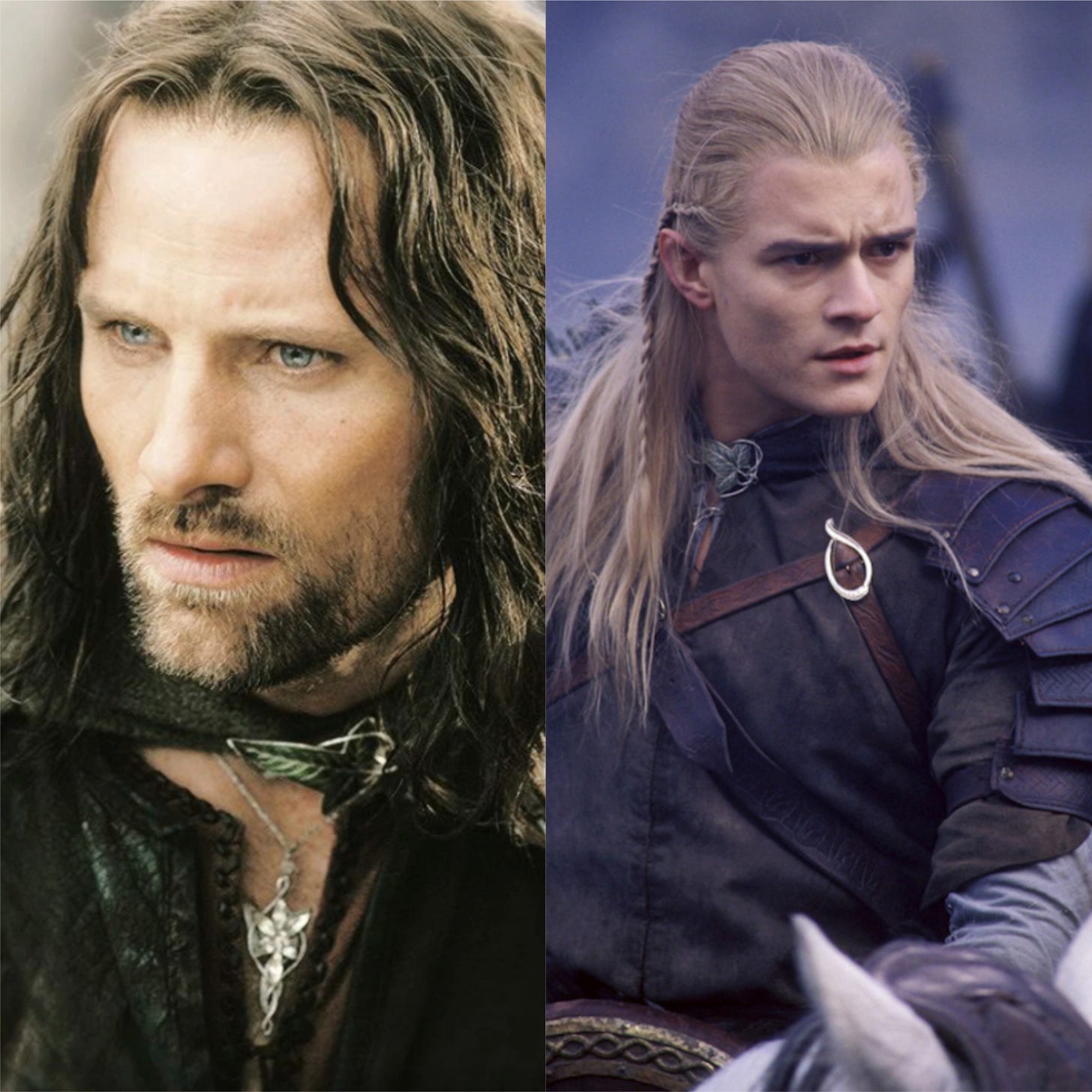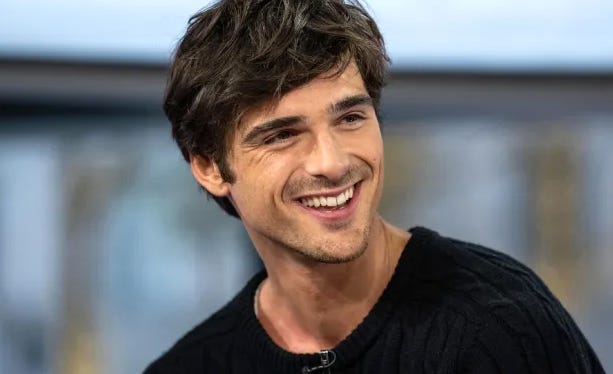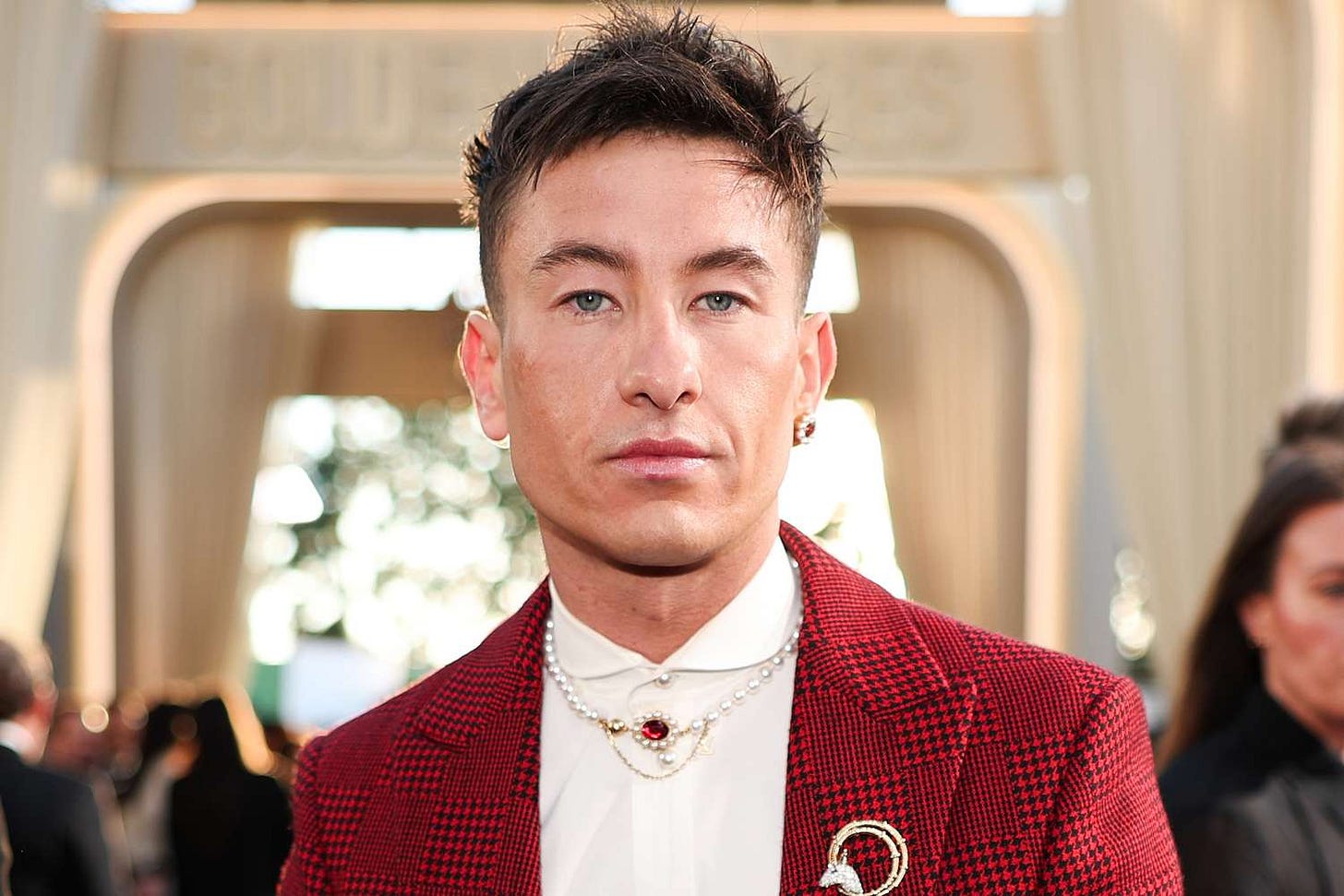The new Aragorn vs. Legolas? Elordi vs. Keoghan.
Masculinity's evolved quite a bit since 2001.
A few weeks ago, a friend and I were chatting Saltburn in the days before its streaming release. I said something lame, like, “Let’s hope there’s plenty of Barry’s Keoghan!” (Get it? This is a reference to a weiner.) My friend said, “You would.” They weren’t referring to my tendency to be incredibly lame, but my tendency to prefer funny-looking weirdos over their perfectly handsome counterparts. Because in a film starring Jacob Elordi and Barry Keoghan, the general assumption is that, if you’re psyched to see one of those dudes in the buff, it’s probably gonna be the guy who looks like a cross between Clark Kent and Michaelangelo’s David, not the one known for playing twitchy psychopaths.
This, naturally, makes me a Legolas Girl. That’s according to one of the most important cultural treatises in recent history: the online article “Are You an Aragorn Girl or a Legolas Girl?”, which Sangeeta Singh-Kurtz wrote for The Cut in 2020. In this excellent dispatch, Singh-Kurtz explains that there are two kinds of people: Aragorn Girls and Legolas Girls. Who you’re more attracted to — whether it’s the rugged, brooding Aragorn, or the gentle, lithe Legolas — functions as a Rorschach test for something fundamental about your sexuality and preferences. Do you prefer the conventional hottie, or the fringe pick? Who would you choose: Aragorn, the hunky lead singer with a perfect 5 o’clock shadow, or Legolas, the long-haired keyboard player with interesting glasses? A crush on Aragorn suggested a preference for good ol’ fashioned red-blooded dudes; for some, a pull toward Legolas’ soft masculinity foreshadowed a queer awakening.

I thought about Aragorn and Legolas while watching Saltburn, a visually beautiful movie about absolutely nothing. Like Aragorn and Legolas, Jacob Elordi (who plays Felix Catton) and Barry Keoghan (who plays Oliver Quick) represent two starkly different expressions of masculinity. Elordi and Keoghan are totally complementary and completely different from one another — Elordi is tall and bronzed, with a swoosh of thick brown hair and a smile that renders the knees weak as hell. Keoghan is striking and intense, with a sort of devilish roughness brewing just behind his blue eyes.
But Elordi and Keoghan are hardly straight analogs of Aragorn and Legolas.
It’s been 23 years since the first Lord of the Rings film was released, and our masculine ideal has changed a lot since the early aughts. The ideal man in the early 2000s was buff, brawny and a little tormented, with rigid ethics and grunts and the emotional intelligence of a beetle. In 2023, our male heartthrobs are thoughtful, sensitive softies in touch with their emotions. They wear dangly earrings and pleated skirts! They carry tote bags from local bookstores! They, like, really love wearing skirts and dresses!
So, yes, Elordi and Keoghan may similarly represent two diverging paths in a horny wood. But it’s more interesting than that, because the forest itself has changed a lot since 2001. The archetypes of “an Aragorn” and “a Legolas” are completely different today, because the recipe for masculinity — and what challenges that masculinity in a way that’s still alluring — is completely different today.
Let’s consider Jacob Elordi. Right now, he’s probably Hollywood’s biggest rising star. (He also carries tiny handbags.) Elordi plays Nate Jacobs in “Euphoria,” a show I’ve been too scared to revisit after starting it while a teeny bit high (does a lot of “Euphoria” take place at a haunted rave, or is it just the opening sequence?), and just portrayed Elvis Presley in Sophia Coppola’s Priscilla.
Elordi is also, uh, stunningly beautiful. He’s got a smooth, dimpled babyface undercut by a Grecian nose and a jawline that could cut through steel. One friend told me Elordi looks like the model of the original man, carved from marble. (He’s also 6’5”.) In a GQ profile peppered with instances of young girls screaming at the sight of Elordi and the magazine writer, the writer describes Elordi as “not so much a tall drink of water as the entire office water cooler.”
We’ve also got Barry Keoghan, who notable roles aren’t exactly a cornucopia of sexuality. Keoghan’s breakout performance came in 2017 (see: the aforementioned spaghetti-slurping sociopath in The Killing of a Sacred Deer). A few years later, he’d earn an Oscar nod for his performance in The Banshees of Inisherin. His character? A heartachingly lonely village idiot. Later this year, Keoghan will attempt to fill some of cinema’s biggest shoes — Heath Ledger’s — and portray the one and only Joker in the sequel to 2022’s The Batman (this deleted scene shows some of Keoghan’s take on the character).
Keoghan has piercing blue eyes and full, cherry red lips, with a face that can flip from sweetly boyish to utterly soulless in a snap. He’s 5’8”, compact but strong, and carries himself like he’s fighting off some buzzing, chaotic force trying to break through the surface. GQ describes Keoghan as being “wolf-like,” with an “unnervingly curving smile and frosty gaze.”
If Aragorn is the conventional leading man and Legolas is the artsy, avant-garde riff on masculinity, it makes sense to equate Elordi to Aragorn and Keoghan to Legolas. But Elordi is no Aragorn! There’s hardly a whiff of self-serious masculinity on him. Remember the tiny purses? In interviews, Elordi feels thoughtful and charming. In high school, when Elordi played Oberon in A Midsummer Night’s Dream and classmates called him gay (a classique insult!) because he wore makeup as Oberon, Elordi “leaned into the makeup,” he said, and added some purple glitter to his face. “I started welcoming the femininity,” he told GQ in 2022. A movie he’s rewatched at least four times? Teenage Mutant Ninja Turtles: Mutant Mayhem. In an especially fun twist for this essay and this essay alone, Elordi told W Magazine in 2021 that his first cinematic crush was on — wait for it! —Legolas.
Next to Elordi, Keogan’s allure feels messier — more dangerous, animalistic. Keoghan is shifty, occupying his body like its something he’s trying to wrestle himself free from. Chloe Zhao, who directed him in Marvel’s The Eternals, said he possesses “this unique, unique spirit that’s almost like his body can’t contain it.” Martin McDonagh, who directed Keoghan in The Banshees of Inisherin, describes Keoghan’s performances as “creepy, and he freaks you out, but it’s truthful and it’s honest.” Keoghan radiates that specific kind of depth that comes from having weathered real trauma: he’s from inner city Dublin, grew up without a father, lost his mother to heroine, got thrown around the foster care system for seven years and was eventually taken in by his grandmother. He’s a boxer; the brutal sport remains as meaningful a pursuit to him as acting. He told GQ earlier this year that, every night, he howls at the moon.
Suffice it to say, Keoghan has a rougher masculinity that more closely mirrors Aragorn than Legolas. In this instance, that makes Aragorn the novel choice! But Keoghan isn’t an Aragorn. He isn’t a Legolas. (He’s a buff Smeagol.) He, nor Elordi, fits cleanly into either silo, because those siloes are outdated today. And twenty three years after The Lord of the Rings’ first release, it’s pretty remarkable just how much Aragorn feels like the fringe than the norm.
Softer masculinity has never been more en vogue. Look at our current roster of pop culture heartthrobs: Elordi, Timothée Chalamet, Harry Styles, Pedro Pascal, Paul Mescal, Jeremy Allen White. None of these men share any particular facial or physical features — some are jacked, others are twigs — but they do all possess a certain … gentleness, no?
It makes sense that people aren’t too keen on gruff he-men anymore. Thanks to #MeToo and the general progression of feminism, lots of us are acutely aware of the toxicity that’s often at the root of traditionally masculine traits. And a lot of us are in therapy, too, and recognize once-charming or endearing idiosyncrasies (“He gets so grouchy when he’s hungry!” “Uh, does he only talk about sports?”) as byproducts of immaturity, or being emotionally stunted, or entitlement.
We didn’t always have words like “patriarchy” and “misogyny” at the tips of our tongues, and that’s because we’ve just gone through a reckoning with masculinity. It’s an entirely new landscape. That Elordi and Keoghan work as a modern template for Aragorn and Legolas is irrefutable, hunky evidence of that evolving terrain.







